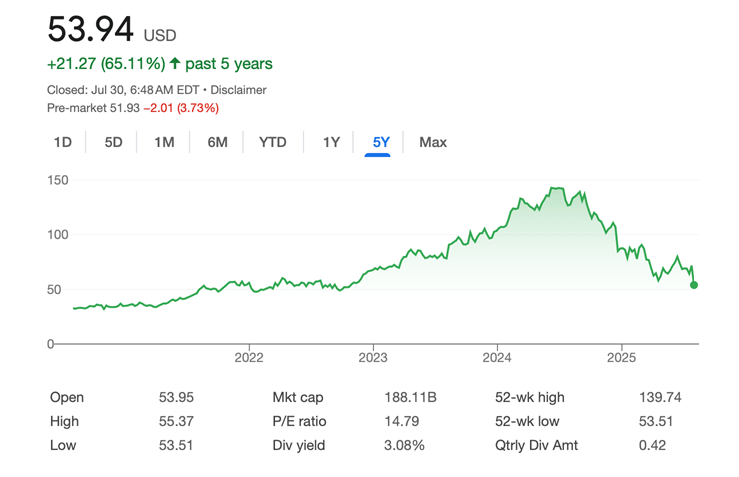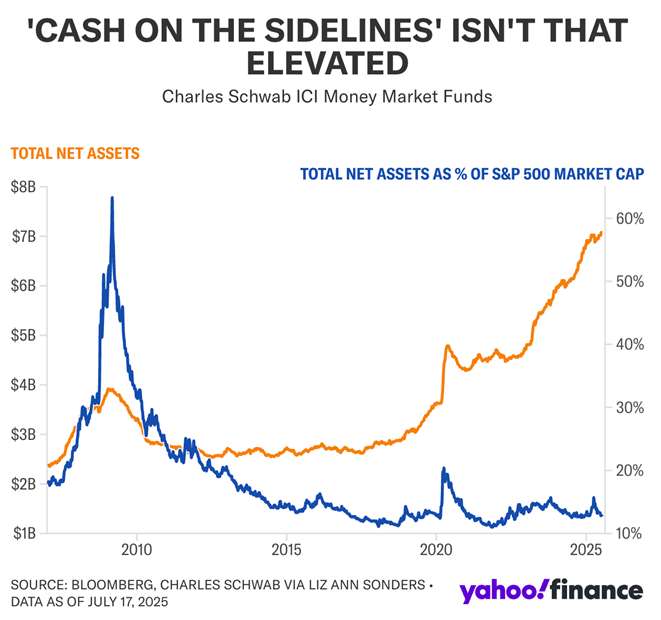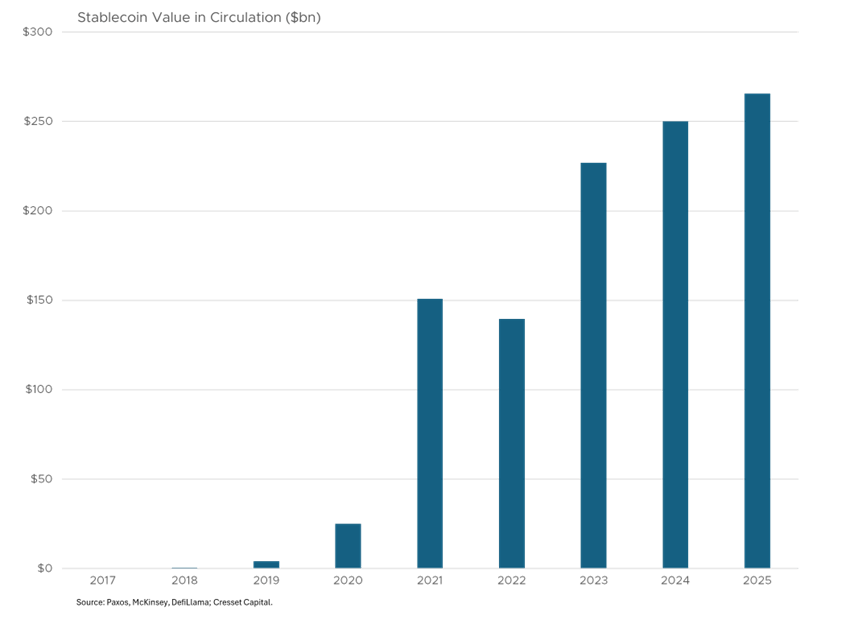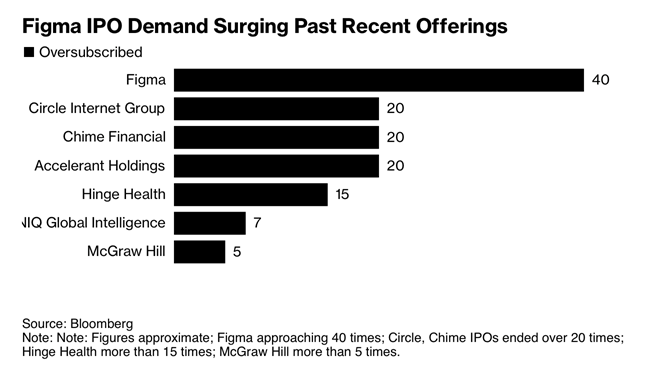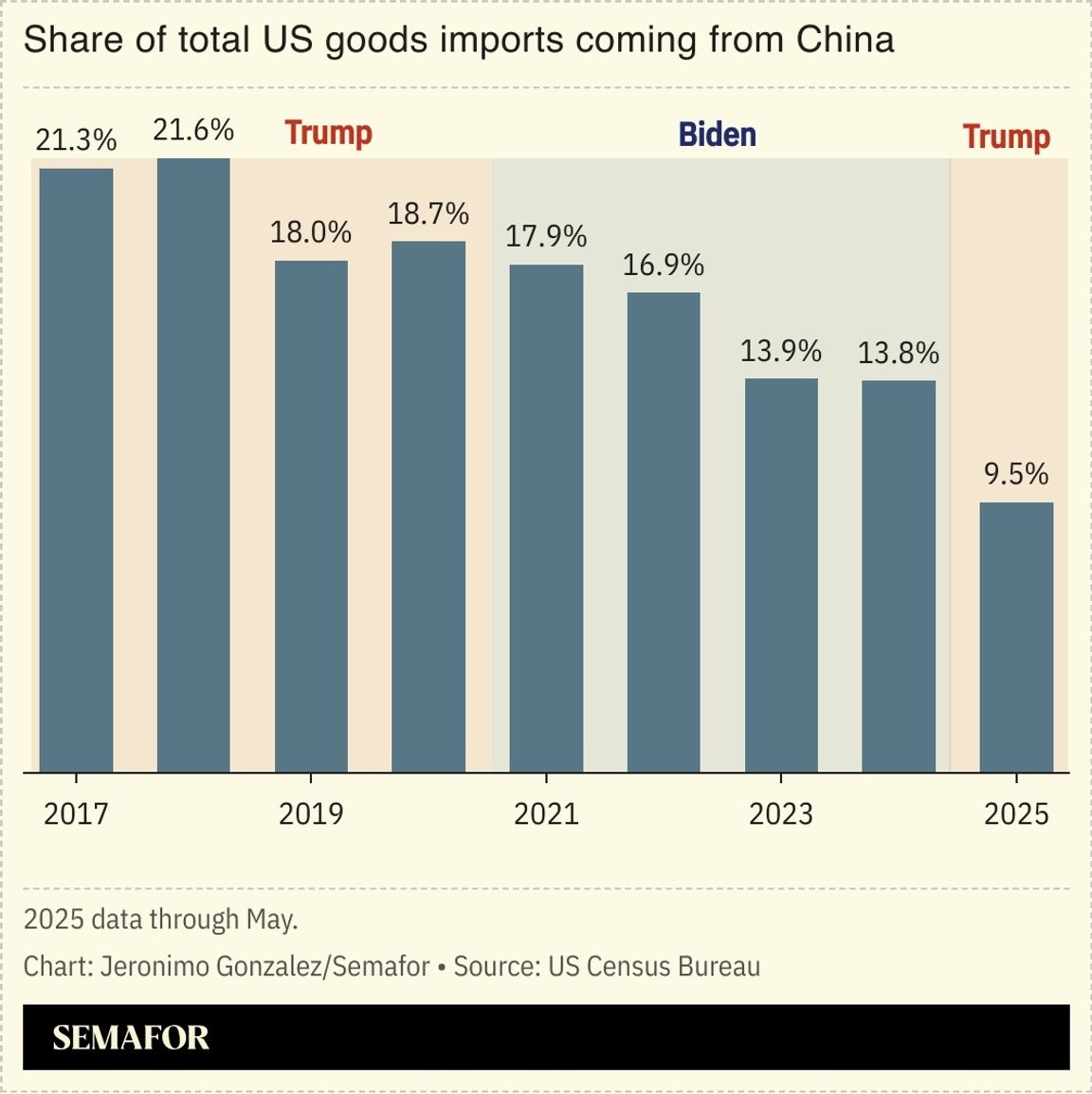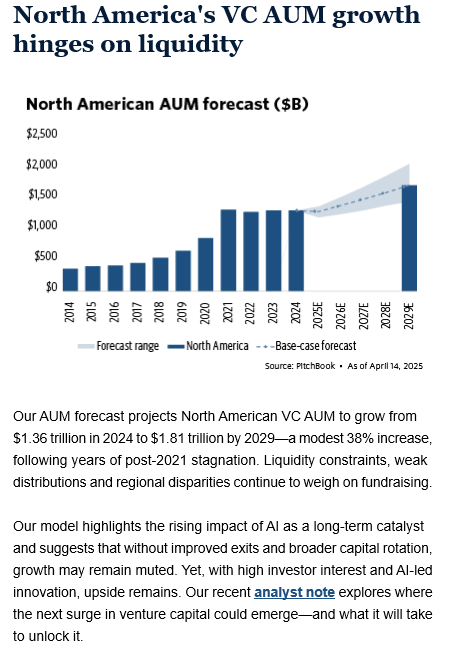- TOPLEY'S TOP 10
- Posts
- Topley's Top 10
Topley's Top 10
Cash on Sideline vs. Total Market Cap
2….
1. Earnings Misses Getting Hit at Higher Level than Historical
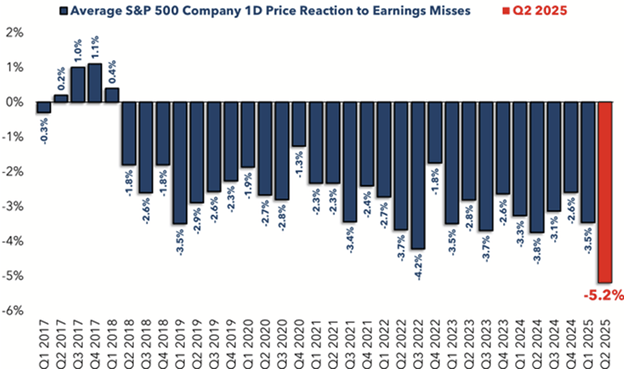
Dave Lutz at Jones Trading
…
…
3. Cash on Sideline vs. Total Market Cap
MMFs vs. SPX. "A lot is made of the 'cash on the sidelines' story when observing assets in money market funds; however, as a share of total equity market value, it’s significantly more subdued."
…
4. Stablecoins Hit $270B in Circulation
Jack Ablin Cresset-The stablecoin market has already reached $270 billion in circulation, with projections suggesting explosive growth ahead. Standard Chartered forecasts the market will reach $2 trillion within three years, while Citigroup projects $1.6 trillion by 2030. This represents growth of nearly 700% from current levels, driven by regulatory legitimacy and institutional adoption.
…
…
6. Starbucks Yearly Revenue Growth

Macro Trends
…
7. U.S. Imports from China Have Been Cut in Half
Trade limbo persists
An extension of the Washington-Beijing tariff detente remains subject to US President Donald Trump’s approval, one of several deals which are in limbo.Chinese negotiators earlier said the two sides agreed to a 90-day extension of their truce, but Washington said it hadn’t yet “given the sign off.” With a tariff reprieve expiring Friday, details over a US-European Union agreement have also been disputed, tariffs on India remain unclear, and African economies are awaiting news. Their dependence on Trump’s whims means “these deals don’t yet represent a new trade order,” The Wall Street Journal’s chief economics commentator wrote. “They are sort of a way station, more fragile and with less legitimacy than the system they have supplanted.” |
…
…
9. I Would Expect A lot of “Fix Housing” Talk from Politicians Local, State, and Federal
By Aarthi Swaminathan via MarketWatch
Republicans and Democrats are joining forces to fix America’s housing affordability crisis. Here’s what’s in their plan.
A bipartisan group of lawmakers propose cutting red tape and boosting modular-home construction to help more Americans buy homes
Home prices hit a new record high in June, putting homeownership out of reach for many buyers. Politicians across the aisle are trying to solve the affordability crisis.
The housing market is mired in a crisis of affordability. Can politicians fix it?
A new bipartisan housing bill introduced by Sens. Tim Scott of South Carolina, a Republican, and Elizabeth Warren of Massachusetts, a Democrat, aims to cut red tape that they say slows housing development and will boost construction of modular homes.
The bill is lawmakers’ latest attempt to address today’s housing crisis.
President Donald Trump recently indicated that he wants to eliminate the capital-gains tax on home sales, which would in theory free up more housing inventory. Homeowners who have seen significant home-price appreciation would not take a tax hit if they were to sell.
The senators’ bipartisan bill comes as home prices just hit an all-time high and mortgage rates remain elevated, which has squeezed many first-time home buyers out of the housing market. Buying a house no longer feels like an attainable goal to many Americans, especially younger ones. The typical age of a home buyer hit an all-time high of 63 in 2024, according to the National Association of Realtors.
The bill was advanced unanimously by the Senate Banking Committee. It’s significant because politicians from both parties are trying to address the issue of housing affordability, Lisa Sturtevant, chief economist at Bright MLS, told MarketWatch.
“In the past, when federal lawmakers talked about ‘affordable housing’ they were referring to subsidized housing for low-income individuals and families,” Sturtevant said. “However, the affordability challenge has moved up the income ladder and more and more Americans are struggling to afford to buy or rent a home.”
As high housing costs burden Americans across the country and across income levels, “elected officials from both sides of the aisle are hearing about those challenges from more of their constituents,” she added.
The bill, called the Renewing Opportunity in the American Dream (ROAD) to Housing Act of 2025, seeks to address a critical issue the housing market is facing right now, which is a shortage of homes for sale. Even though supply has been rising sharply, homes are still too expensive for most buyers, and high mortgage rates make affordability even worse.
The bill now goes to the full Senate chamber for a vote. It is expected to be approved before Congress breaks for recess in August, Jaret Seiberg at TD Securities wrote in a note. If it passes the Senate, the House would vote on the bill, or amend it. The bill would then go back to the Senate, and if approved, to the White House.
To be sure, the legislation is still a proposal and far from a silver bullet that will solve the housing market’s current woes. But it does signal that politicians are paying attention to the problem.
“We view these provisions as helpful for housing, but they are not game-changers for home builders or mortgage lenders,” Seiberg wrote. “Many are pilot programs or narrow legislative changes. They are not going to change the economics of buying or building a house.”
Mark Zandi, chief economist at Moody’s Analytics, agreed. In a social-media post, he said that while it’s “no game-changer … policymakers are finally in the game” in terms of responding to the housing crisis.
The National Association of Realtors, the Real Estate Roundtable, the Mortgage Bankers Association and the National Apartment Association all released statements supporting the bill.
…
10. How to Achieve Higher Performance in Your Everyday Life
Strategies to make self-discipline and focus feel easier.
KEY POINTS
Perceived effort isn't fixed; factors like music or habit can make tasks feel easier.
Habits reduce perceived effort, which can ease daily tasks and boost self-discipline.
Experiment with ways to lower perceived effort for greater self-discipline.
When you think of high performance, you might think of a test or a race. However, we can also strive to perform at a higher level in anything we do in our everyday lives.
The focus of this post is on one particular mechanism to achieve this: When we reduce how effortful our tasks feel, we enable ourselves to sustain greater objective effort (and can achieve greater mental and physical endurance).
Perceived Effort (or Perceived Exertion) and Task Performance
Imagine you're running on a treadmill, and someone is gradually notching up the speed. You'll reach a point where the effort feels too much, and you'll decide to step off.
It's clear that our perception of effort will go up when what we're attempting is objectively more strenuous. But, in fact, identical actions can feel more or less effortful depending on the circumstances. We've probably all felt this. Some days our daily routine feels harder than other days.
The topic of perceived exertion has been extensively studied in endurance sports (like long-distance running and cycling), but many of the same principles (and some of the same techniques) carry over to activities that only require mental endurance.
For example, we know that factors like caffeine and music can decrease perceived effort. Sports science tells us that cycling often feels less effortful when the rider is listening to music. Extrapolating from this, we can easily test for ourselves whether everyday activities like tidying up or washing a sink full of dishes feel less effortful with music.
In the sphere of mental effort, there's an incredible range of what influences our perceptions of effort.
Expectation effects can reduce perceived effort. For example, when I learned that reading to children reduces feelings of stress in parents, I started to notice this. Reading to my toddler started to feel pleasant rather than like a slog. Knowing that research says this should reduce stress made this more true for me.
A core benefit of habits is that they reduce perceived effort. A behavior that's a habit feels easier than when the same behavior is new to us. Habits and routines are such a powerful tool for higher performance exactly because they reduce our need for self-control.
Other options that can influence how effortful a particular action feels:
· Whether you're tired, hungry, or hot.
· The presence of other people.
· Being in nature or beautiful surroundings.
· How long you expect to have to keep going at the same effort (an activity often feels easier when we know we're almost at the finish).
· Whether there's a known endpoint (waiting feels more effortful when we don't know how long we'll need to wait).
· The relative effort of a task compared to your other tasks (tidying up feels easier if the alternative is studying for exams than if the alternative is watching YouTube).
· Fitness, or being accustomed to a certain level of effort. When we're fitter, we perceive operating at near our max as easier. It's less scary. Athletes and fitness enthusiasts who are accustomed to the physical discomfort of exertion tolerate it better. It's conceivable that this principle also applies to people who are accustomed to high levels of mental focus and endurance.
(For a discussion of the underlying research, catch this podcast episode.)
Negative Self-Talk Adds to Perceived Effort
You can approach the problem of perceived effort by introducing factors that reduce it, or by eliminating factors that increase it.
Overly dramatic self-talk that amps up negative emotions (e.g., "This is so hard and miserable, I hate it") can increase perceived effort, as can various types of overthinking, like second-guessing your plans instead of just executing them.
Approach Your Perceived Effort With an Experimenter's Mindset
The ideas presented in this post represent only a small selection for you to explore. Once you recognize that you can influence your perceived effort, and get yourself to do more effortful behaviors if you can lower your perceived effort, you can easily experiment to see what works for you.
This is an ideal self-improvement topic to approach through personal experimentation. It's especially relevant if you're seeking to be more focused and self-disciplined. Knowing how to reduce your perceived effort can increase your persistence when you're expecting a lot of yourself. (To learn how to be a better self-experimenter, see this post.)
…
Did someone forward this email to you? Get your own:
Disclosure
Indices that may be included herein are unmanaged indices and one cannot directly invest in an index. Index returns do not reflect the impact of any management fees, transaction costs or expenses. The index information included herein is for illustrative purposes only.
Material for market review represents an assessment of the market environment at a specific point in time and is not intended to be a forecast of future events, or a guarantee of future results.
Material compiled by Lansing Street Advisors is based on publicly available data at the time of compilation. Lansing Street Advisors makes no warranties or representation of any kind relating to the accuracy, completeness or timeliness of the data and shall not have liability for any damages of any kind relating to the use such data.
To the extent that content includes references to securities, those references do not constitute an offer or solicitation to buy, sell or hold such security as information is provided for educational purposes only. Articles should not be considered investment advice and the information contain within should not be relied upon in assessing whether or not to invest in any securities or asset classes mentioned. Articles have been prepared without regard to the individual financial circumstances and objectives of persons who receive it. Securities discussed may not be suitable for all investors. Please keep in mind that a company’s past financial performance, including the performance of its share price, does not guarantee future results.
Lansing Street Advisors is a registered investment adviser with the State of Pennsylvania.
